
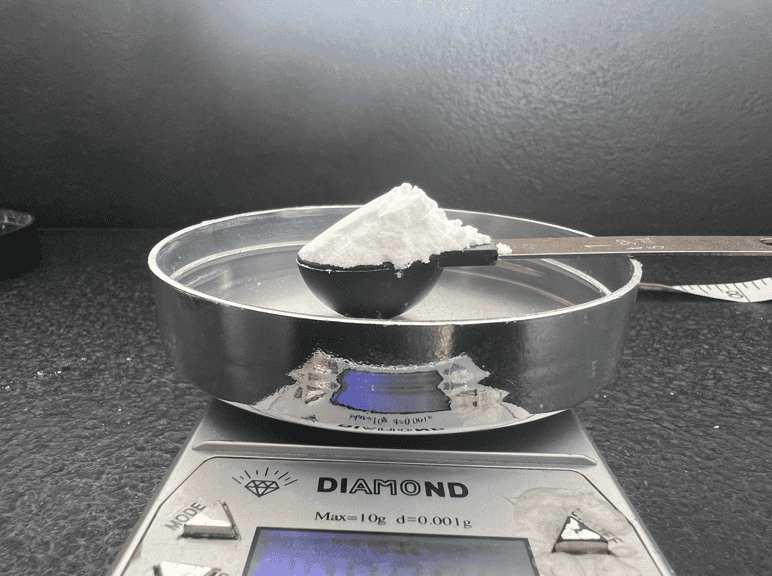
Creatine is the standard when it comes to picking the most necessary supplements.
Creativity will likely be in your arsenal when you're committed to making gains.
The reason for this is that it plays a vital role in ATP production, a source of energy for muscle, and high-intensity exercise.
The dose for creatine is 5 grams but this is hard to measure without a scale.
What does 5 grams of creatine actually look like, will be shown below...
Creatine is one of the most used supplements.
But this means there's probably a lot of confusion around this supplement.
One of them being is how to tell what does 5g of creatine looks like.
Dosing creatine correctly is good to know as you don't need more than 5 grams.
Measuring the right amount can be hard without a proper scale or it may just have not come with a scoop.
So this guide will help you visualize what 5 grams of creatine looks like.
If you're using micronized creatine, then the video below will help you visualize what 3 and 5 grams of creatine looks like.
If you're using micronized creatine, then the video below will help you visualize what 3 and 5 grams of creatine looks like.
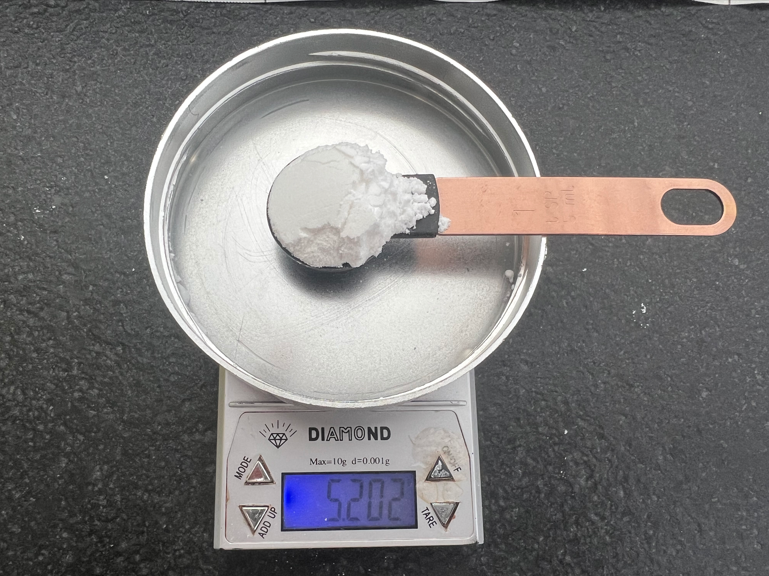

That's what 5g of creatine looks like.
The 5ml teaspoon used contains a heaping amount of creatine.
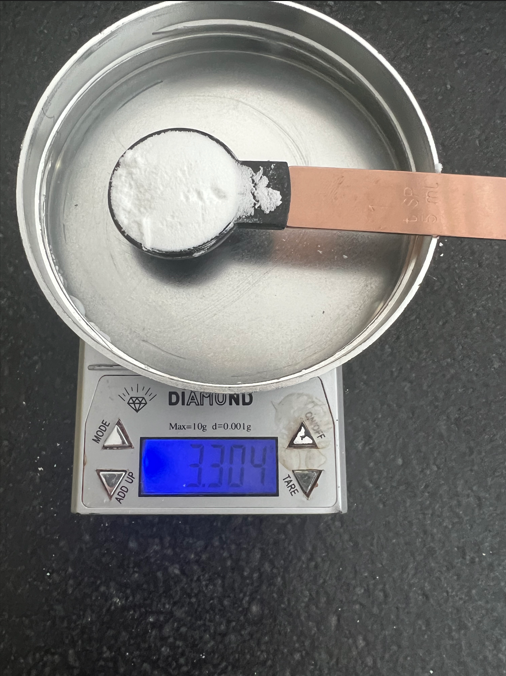
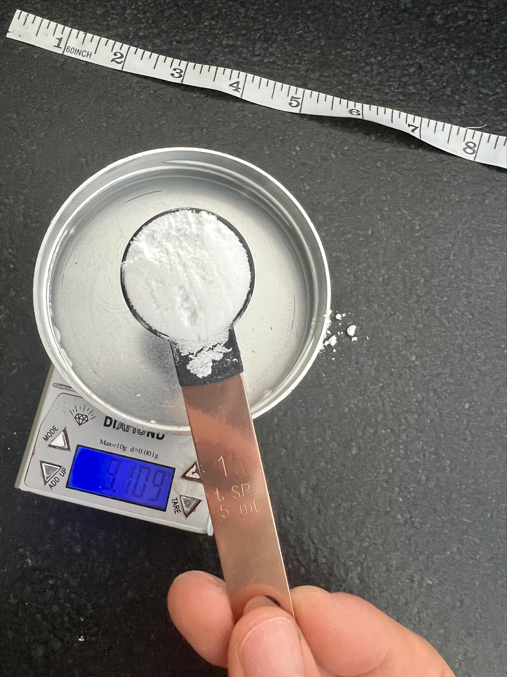
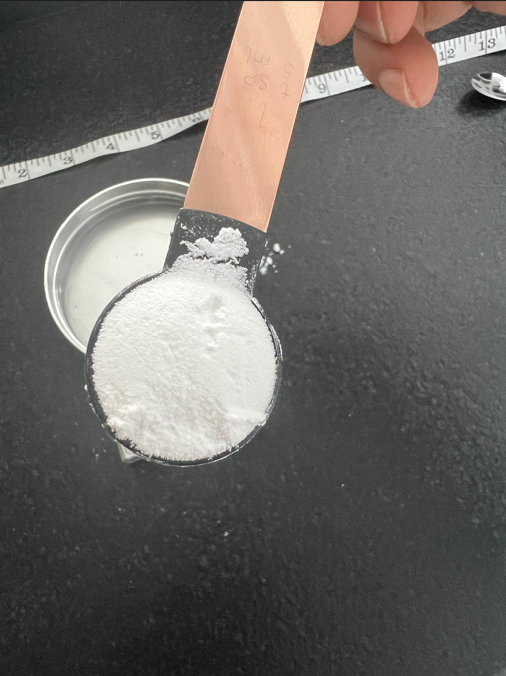
As you can see in the pictures above, 3g of creatine in a teaspoon is quite flat.
There is no heaping powder on top unlike the 5g of creatine.
If you'd like to get a scale, like the one shown in the photos, then you can get one here.
If you don't have a measuring spoon, then you can take a look at the pictures below of what 3g of creatine looks like in a normal teaspoon.
This teaspoon is used to add sugar to tea and coffee.
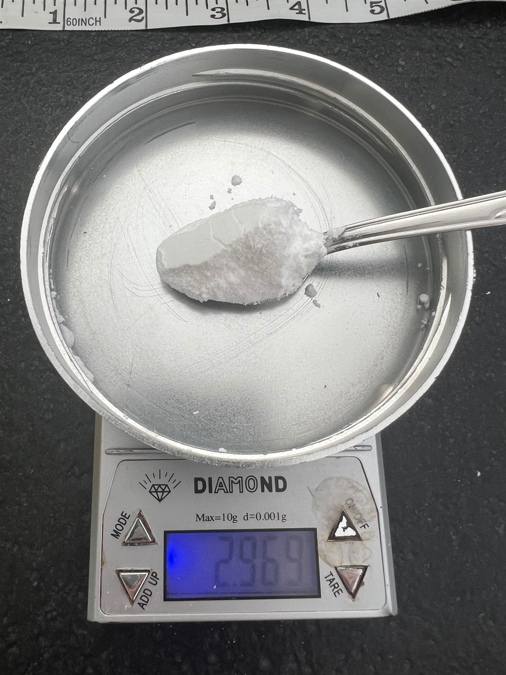

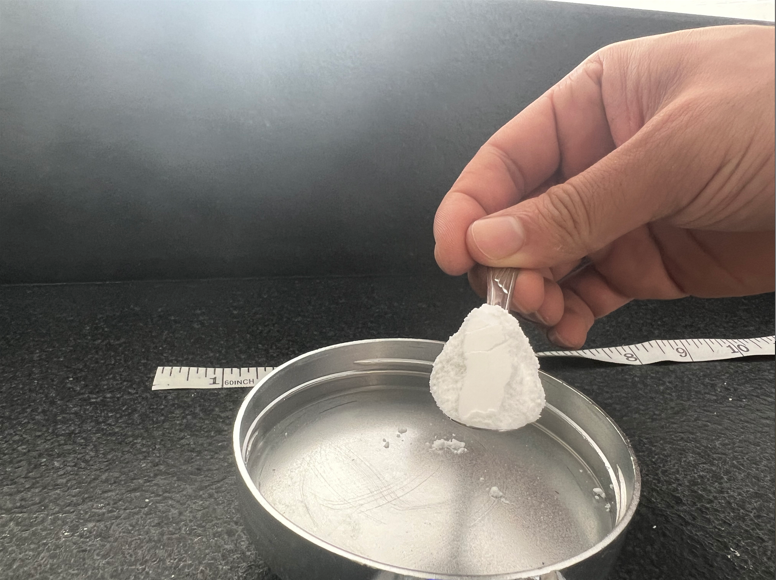
The teaspoon would have to be a heaping spoonful of creatine to be 3g of creatine.
You can see how it looks in the pictures above.
Using the pictures above you can see what 5 grams of creatine looks like.
A teaspoon is the best way to measure creatine if you don't already have a scale.
One and a half teaspoons of creatine will measure out to be around 5 grams in total.
Alright, let's break this down.
From the information gathered from the three sources, we can see that there's a bit of a debate about the exact conversion of 5 grams of creatine to milliliters.
However, the consensus seems to be that 5 grams of creatine is roughly equivalent to somewhere between 3.3 to 7.5 milliliters.
Here's the scoop (pun intended):
According to a Quora post, 5 grams of creatine is close to 5 milliliters.
A Reddit thread suggests that 5 grams of creatine monohydrate is approximately 7.5 milliliters (a rounded teaspoon).
A Bodybuilding forum thread provides a range of answers, with one user suggesting that 5 grams of creatine powder equals 3.3 milliliters, while another user suggests that 5 grams are about 7.5 milliliters.
Given this information, it's important to note that the conversion can vary based on the density of the creatine powder, which can be influenced by factors such as the specific type of creatine and the level of compaction in the scoop.
Therefore, for the most accurate measurement, it's recommended to use a scale that can measure grams.
However, if a scale isn't available, using a milliliter measurement can provide a rough estimate, keeping in mind the potential for variation.
Using the pictures above you can see what 5 grams of creatine looks like.
A teaspoon is the best way to measure creatine if you don't already have a scale.
One and a half teaspoons of creatine will measure out to be around 5 grams in total.
It's agreed widely that 5 grams is the standard dose.
Though you can use 3 grams, you'll need to use a high-quality source of creatine like creatine HCL or CreaPure.
To measure out 3 grams of creatine, you'll want to use one flat teaspoon.
If you take more than 5g of creatine then you'll likely experience stomach discomfort or gas but nothing serious.
It's been shown in research that you can take up to 20g repeatedly without serious side effects. [1, 2]
Even your kidneys are going to be safe from that much creatine. [3]
Some recommend using 5-7 days to load up with 20g of creatine on a daily basis then reducing the dosage to 3-5g per day.
I personally only take 5g of creatine, even if I'm loading on it.
Generally, there are no known effects for long-term usage of creatine, but just like any supplement, it would be wise to take a month's break every few months of usage.
This month's break isn't only for tolerance resetting but it will also just give your body a break from digesting powders.
Yes, 3g is enough to maintain optimal creatine stores daily.
But if you're taking 3g, you may as well be taking 5g.
Taking 5g per day ensures you're getting enough creatine to benefit from it.
It's a cheap supplement, there's no reason why you should take 3g over 5g.
Creatine is a naturally occurring substance found in muscle cells.
It's a type of amino acid that plays a crucial role in energy production, particularly during high-intensity workouts
When you're pushing your limits, your body uses ATP (adenosine triphosphate) as a source of energy.
However, ATP stores deplete quickly during intense exercise, and that's where creatine comes in.
Creatine helps replenish ATP stores, allowing you to maintain high-intensity exercise for longer periods.
Creatine is regarded to be one of the safest supplements available today.
However, it is possible to experience side effects if you take too much.
Side effects can include upset stomach discomfort, gas, and diarrhea.
Some sources say you can take up to 20 grams of creatine for a week, this is known to be the loading phase.
But in my experience, a solid 5-gram per day serving is more than enough.
The best form of creatine and the most researched is creatine monohydrate.
But we also like creatine HCL, check out our guide here.
The cheapest and the form you can't go wrong with is creatine monohydrate.
Don't have a scale? No problem.
You can use a teaspoon as a handy measuring tool. A flat teaspoon of creatine powder weighs about three grams.
To get to 5 grams, you just need to add another half a teaspoon. It's as simple as that!
The standard recommended dose for creatine supplementation is 3-5 grams per day. This is based on the assumption that you're an adult with a healthy body weight.
However, individual needs may vary depending on factors such as body size, sensitivity to supplements, diet, exercise routine, and genetics.
While creatine is generally safe, taking more than the recommended daily dose can lead to non-serious side effects like stomach discomfort or gas. Some people opt for a "loading phase," where they take up to 20 grams of creatine per day for the first 5 to 7 days, then reduce to a daily dose of 3 to 5 grams.
However, for most people, a consistent daily dose of 5 grams is sufficient.
Creatine, the superstar of fitness supplements, is like the Swiss army knife of the workout world. It's got a tool for just about everything. Let's dive into some of the amazing benefits it brings to the table:
1. Supercharges Your Muscle Cells:
Creatine is like a battery booster for your muscle cells. It ramps up your muscles' phosphocreatine stores, which in turn helps produce more ATP, the key molecule your cells use for energy. This means you can push harder, lift heavier, and squeeze out those extra reps during your high-intensity workouts.
2. Fuels Muscle Growth:
Want to pack on more muscle? Creatine has got your back. It not only boosts the formation of proteins that create new muscle fibers but also increases the water content in your muscles, making them look bigger and fuller. Plus, it can even reduce levels of myostatin, a molecule that puts the brakes on muscle growth.
3. Enhances High-Intensity Exercise Performance:
Creatine is like the secret sauce that spices up your high-intensity workouts. It improves a whole host of factors, including strength, sprint ability, and muscle endurance, helping you perform at your peak, no matter your fitness level.
4. Battles Neurological Diseases:
Creatine isn't just about muscles and workouts. It also plays a crucial role in brain health. Research suggests that it can help fight several neurological diseases by increasing phosphocreatine levels in the brain.
5. Helps Control Blood Sugar Levels:
Creatine might also be a handy tool in your blood sugar management toolkit. It's been shown to lower blood sugar levels by increasing the function of GLUT-4, a molecule that shuttles sugar into your muscles.
6. Boosts Brain Function:
Your brain needs a ton of ATP when tackling difficult tasks. Creatine can increase phosphocreatine stores in your brain, helping it produce more ATP and boosting brain function.
7. Reduces Fatigue:
Feeling wiped out after your workouts? Creatine can help. It's been shown to reduce fatigue and increase energy levels, helping you recover faster and get ready for your next session.
8. Safe and Easy to Use:
The best part? Creatine is one of the safest and most well-researched supplements out there. Plus, it's super easy to use. Just take 3–5 grams of creatine monohydrate powder per day, and you're good to go.
In the bustling market of fitness supplements, creatine stands out with its unique forms, each boasting its own set of perks and benefits.
Ready to meet the usual suspects? Here they are:
Creatine Monohydrate:
Meet the most popular kid on the block. Creatine Monohydrate is the go-to choice for most fitness enthusiasts and for good reason. It's got a solid track record, backed by a ton of research. Its superpower? High solubility and improved bioavailability. This means it gets absorbed into your muscles like a champ. And the cherry on top? Most of the awesome benefits we associate with creatine come from this very form.
Buffered Creatine (Kre-Alkalyn):
Here's a creatine that's got a bit of a twist. Kre-Alkalyn, a buffered form of creatine, comes with a dash of alkaline powder. Why, you ask? Well, this little addition is believed to cut down on creatine breakdown in your stomach and boost its uptake into your muscles. You'll often find this guy hanging out in many pre-workouts. And the best part? No loading phase is required.
Creatine Hydrochloride (HCL):
Say hello to the compact powerhouse. Creatine HCL is a micronized form of creatine, which basically means you can take less to achieve more. It's like getting the same bang for fewer bucks. Plus, it's said to need less water, which can be a game-changer if you're not a fan of the bloating and other tummy troubles that can come with creatine monohydrate.
Creatine Nitrate:
This form of creatine is often found flexing its muscles in pre-workouts. The claim to fame here is that by tying the creatine molecule to a nitrate molecule, you get the same benefits from a smaller dose of creatine nitrate as you would from creatine monohydrate.
While these creatine variants each bring something unique to the table, more research is needed to evaluate their safety at higher dosages and their comparative effects on performance. But for now, it seems like Creatine Monohydrate is still wearing the crown as the most effective form of creatine.
Recent advancements in creatine research have broadened our understanding of its benefits and safety.
This overview incorporates the latest findings with an emphasis on how they may influence supplementation practices.
Creatine's benefits are now known to extend beyond the realm of male athletes, with studies revealing positive effects across various groups:
The exploration into creatine's cognitive effects has unveiled promising results:
Concerns regarding creatine's long-term impact have been largely dispelled:
Debunking myths around creatine and hydration, recent studies have clarified its effects:
The scope of creatine's benefits may reach into therapeutic areas:
The updated body of creatine research reinforces the supplement's safety and multi-faceted benefits.
While it continues to be a staple for athletes, its potential for cognitive and therapeutic use is becoming increasingly apparent.
As always, individuals should seek professional medical advice before starting any new supplementation, especially in light of ongoing scientific developments.
What does 5 grams of creatine look like?
If you're using micronized creatine, 5 grams is approximately one and a half teaspoons.
Can I take more than 5 grams of creatine a day?
While it's generally safe to take more than 5 grams, it can lead to non-serious side effects like stomach discomfort or gas. Stick to the recommended daily dose of 3-5 grams.
Do I need to cycle creatine?
There are no known effects from long-term usage of creatine, but just like any supplement, it would be wise to take a month's break every few months of usage.
What's the best form of creatine?
The most researched and commonly used form is creatine monohydrate. However, some people prefer creatine HCL for its solubility and absorption rate.
Are there side effects to creatine?
Creatine is generally safe, but taking more than the recommended daily dose can lead to non-serious side effects like stomach discomfort or gas.
Can I take creatine without working out?
Yes, you can take creatine without working out. However, to reap the full benefits of creatine, it's best to combine it with regular high-intensity exercise.
What happens if I stop taking creatine?
When you stop taking creatine, your muscles will no longer receive the extra energy boost provided by the supplement. However, you will not lose muscle mass or strength that you have gained through your workouts.
Can I mix creatine with protein powder?
Yes, it's perfectly fine to mix creatine with protein powder. In fact, some people find it more convenient to take their supplements this way.
Is creatine suitable for vegetarians and vegans? Yes, creatine is suitable for vegetarians and vegans. It's synthetically produced and does not contain any animal products.
Does creatine cause weight gain?
Creatine can cause weight gain due to water retention in the muscles. This is not fat gain, but rather, it makes your muscles appear fuller and larger. Read how much water should you drink with creatine.
Does creatine affect sleep?
There's no evidence to suggest that creatine affects sleep. However, everyone is different, and it's always best to monitor your own response to any supplement.
Can I take creatine if I'm pregnant or breastfeeding?
There's not enough research to confirm the safety of creatine use during pregnancy or breastfeeding. It's always best to consult with a healthcare provider before starting any new supplement regimen during these periods.
The pictures and video above will show you what 5g and 3g of creatine looks like.
If your creatine supplement didn't come with a scoop, fear not, you can use the guide above.
And the measurement doesn't have to be perfect, but at least now you have an idea of how 5g and 3g of creatine looks like.
And there you have it, folks.
We've journeyed through the world of creatine, from understanding what 5 grams of this power-packed supplement looks like, to exploring its various forms and diving into its incredible benefits.
We've even tackled some of your burning questions along the way.
Remember, whether you're a seasoned gym-goer or a fitness newbie, creatine can be a game-changer in your workout routine.
But like any supplement, it's all about finding what works best for you. So, don't be afraid to experiment, ask questions, and do your research.
And hey, if you ever find yourself scratching your head over a scoop of creatine, just remember our little chat here.
Because in the world of fitness, knowledge is just as important as the weight you lift.
So, ready to power up your workout with creatine? Let's make those gains!
Useful Links
 About FitFrek
About FitFrekFitFrek operates as an independent platform, offering comprehensive workouts, programs, routines, guides, and unbiased reviews to accelerate your progress. We pride ourselves on our honesty, delivering straightforward and candid insights. FitFrek does not offer medical advice, diagnosis, or treatment services.